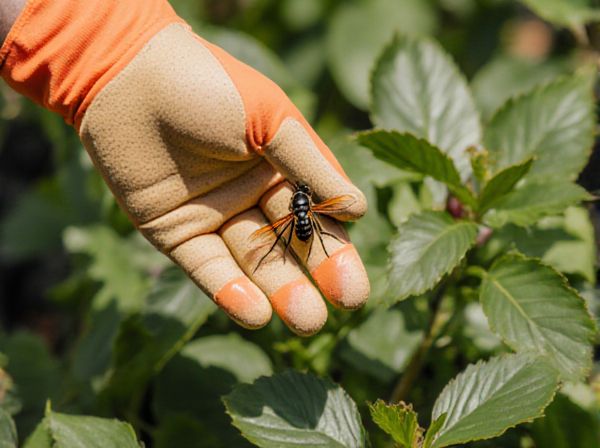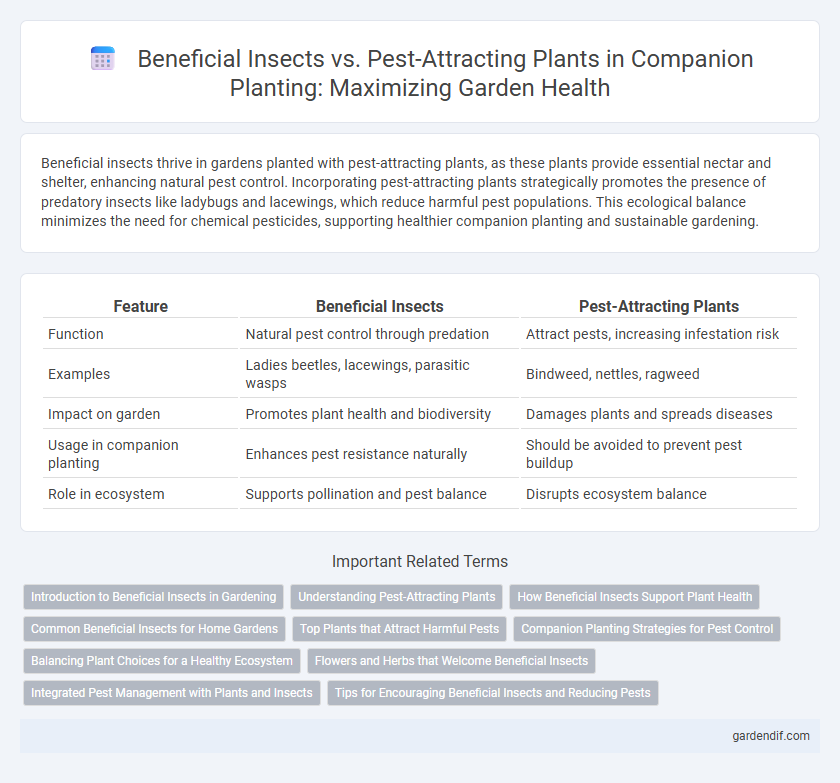
Beneficial insects vs pest-attracting plants Illustration
Beneficial insects thrive in gardens planted with pest-attracting plants, as these plants provide essential nectar and shelter, enhancing natural pest control. Incorporating pest-attracting plants strategically promotes the presence of predatory insects like ladybugs and lacewings, which reduce harmful pest populations. This ecological balance minimizes the need for chemical pesticides, supporting healthier companion planting and sustainable gardening.
Table of Comparison
| Feature | Beneficial Insects | Pest-Attracting Plants |
|---|---|---|
| Function | Natural pest control through predation | Attract pests, increasing infestation risk |
| Examples | Ladies beetles, lacewings, parasitic wasps | Bindweed, nettles, ragweed |
| Impact on garden | Promotes plant health and biodiversity | Damages plants and spreads diseases |
| Usage in companion planting | Enhances pest resistance naturally | Should be avoided to prevent pest buildup |
| Role in ecosystem | Supports pollination and pest balance | Disrupts ecosystem balance |
Introduction to Beneficial Insects in Gardening
Beneficial insects such as ladybugs, lacewings, and predatory beetles play a crucial role in sustainable gardening by naturally controlling pest populations. These insects thrive in environments with companion plants that provide nectar, pollen, and shelter, enhancing the garden's ecological balance. Selecting plants like marigolds and dill attracts beneficial insects while deterring harmful pests, promoting healthy plant growth without chemical interventions.
Understanding Pest-Attracting Plants
Pest-attracting plants often emit specific scents or produce nectar that lures harmful insects such as aphids, whiteflies, and caterpillars, increasing the risk of crop damage. Understanding these plants, like mustard and marigold, helps gardeners strategically plant them away from valuable crops to reduce pest populations. This knowledge supports the creation of an effective companion planting design that manages pests naturally without relying on chemical pesticides.
How Beneficial Insects Support Plant Health
Beneficial insects such as ladybugs, lacewings, and predatory beetles play a crucial role in maintaining plant health by naturally controlling pest populations, reducing the need for chemical pesticides. These insects enhance pollination, improve soil quality through aeration, and contribute to a balanced ecosystem that supports plant growth and resilience. Their presence encourages healthier plants by mitigating damage from harmful pests like aphids and caterpillars, promoting higher crop yields and sustainable gardening practices.
Common Beneficial Insects for Home Gardens
Ladybugs, lacewings, and predatory wasps are common beneficial insects that naturally control aphids, mites, and caterpillars in home gardens. Planting marigolds, dill, and fennel attracts these predators and improves pest management without chemicals. Avoiding pest-attracting plants like mustard or nasturtium reduces infestations, enhancing the effectiveness of beneficial insects.
Top Plants that Attract Harmful Pests
Top plants that attract harmful pests include French marigolds, which are known to draw spider mites, and sweet alyssum, often targeted by aphids. Nasturtiums act as a magnet for whiteflies and caterpillars, while sunflowers can attract leafhoppers and beetles that damage nearby crops. Understanding these pest-attracting species is crucial for effective companion planting strategies to minimize pest infestations and protect garden health.
Companion Planting Strategies for Pest Control
Companion planting strategies leverage beneficial insects such as ladybugs, lacewings, and parasitic wasps, which are attracted to plants like dill, fennel, and marigold to naturally control pest populations. Selecting pest-attracting plants strategically can divert harmful insects away from vulnerable crops, reducing reliance on chemical pesticides and enhancing garden biodiversity. Integrating these companion plants promotes a balanced ecosystem, improving plant health and yield through natural pest management.
Balancing Plant Choices for a Healthy Ecosystem
Balancing plant choices by incorporating beneficial insects-attracting plants while minimizing pest-attracting species promotes a healthy ecosystem in companion planting. Plants such as marigolds, dill, and fennel enhance natural pest control by supporting predatory insects like ladybugs and lacewings. Strategic selection of these plants reduces reliance on chemical pesticides, fostering biodiversity and improving overall garden resilience.
Flowers and Herbs that Welcome Beneficial Insects
Flowers like marigolds, cosmos, and calendula attract beneficial insects such as ladybugs, lacewings, and hoverflies that prey on pests, improving garden health naturally. Herbs including dill, fennel, and coriander provide nectar and shelter for parasitic wasps and predatory beetles, enhancing pest control through biological balance. Cultivating these companion plants increases pollination, reduces chemical pesticide need, and supports a robust ecosystem.
Integrated Pest Management with Plants and Insects
Beneficial insects such as ladybugs, lacewings, and parasitic wasps play a crucial role in Integrated Pest Management (IPM) by preying on common garden pests like aphids and whiteflies. Planting pest-attracting species like marigolds, nasturtiums, and sunflowers can lure pests away from valuable crops, reducing damage and minimizing the need for chemical pesticides. Combining pest-repellent plants with habitats that support beneficial insect populations enhances natural pest control and promotes sustainable agricultural practices.
Tips for Encouraging Beneficial Insects and Reducing Pests
Planting nectar-rich flowers like marigolds, lavender, and yarrow attracts beneficial insects such as ladybugs, lacewings, and parasitic wasps that naturally control pest populations. Avoiding pest-attracting plants like mustard greens and sunflowers reduces the habitat for harmful aphids, whiteflies, and caterpillars. Incorporating diverse plant species, maintaining healthy soil, and minimizing pesticide use create an ideal environment for beneficial insects to thrive while suppressing pest outbreaks.
Beneficial insects vs pest-attracting plants Infographic

 gardendif.com
gardendif.com